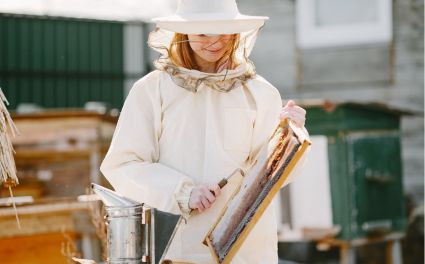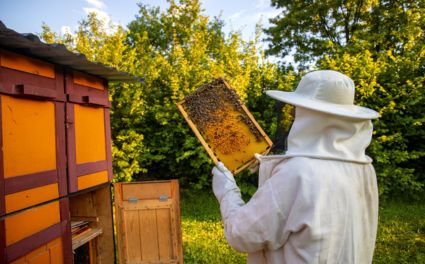Ever wondered why carpenter bees won’t leave your wood alone?
If you've ever stepped outside and noticed small, round holes in your wooden deck, fence, or shed, you might be dealing with carpenter bees. Far from honeybees, these solitary insects don’t build hives — they prefer drilling into untreated wood to create cozy nesting tunnels. And while they don’t eat the wood like termites, the damage they cause can quickly add up.
So, how do you keep them from turning your property into their personal construction zone?
What Time Of Year Do Carpenter Bees Show Up? And Why You Should Care?
Carpenter bees aren’t humming around year-round; they have a schedule, and knowing it can give you an advantage. Their activity kicks off in early spring when temperatures rise, signaling their mating season. This is when you’ll notice them hovering near wooden surfaces, scouting out potential nesting spots.
If you don’t act early, they’ll return year after year, expanding their tunnels and causing even more damage. By catching them at the start of the season, you can prevent a full-blown infestation before it even begins.

Why Do Carpenter Bees Drill Into Wood? Are They Just Wreaking Havoc For Fun?
Contrary to what it may seem, carpenter bees aren’t chewing through wood just to annoy you. They’re on a mission to build the perfect nursery for their offspring. Female carpenter bees bore into soft, untreated wood, creating tunnels where they lay their eggs.
The downside? Those holes weaken your wooden structures, and over time, they can become serious problem areas. If you’ve got exposed, unpainted wood, consider it a flashing welcome sign for these little drillers.
Can Vinegar Spray Really Get Rid Of Carpenter Bees?
Looking for a natural, chemical-free way to send carpenter bees packing? Many homeowners swear by vinegar spray as a DIY deterrent.
Simply mix equal parts white vinegar and water, then spray it directly into the tunnels. The strong acidity makes their nesting environment inhospitable, encouraging them to relocate. While it’s a good temporary fix, vinegar alone won’t solve the problem.
You’ll need a combination of strategies to keep them from coming back — and having the right beekeeping equipment for the job makes it easier.
Are Homemade Carpenter Bee Traps Worth The Effort?
If you enjoy a good DIY project, making a carpenter bee trap can be an effective way to reduce their numbers. These traps typically consist of a softwood block with angled holes leading into a glass jar. Once the bees crawl inside, they struggle to find their way back out.
While homemade traps can work, they require regular maintenance and emptying. If you’d rather skip the hassle, commercial traps designed to mimic their natural nesting preferences might be a better option. You can also include them as part of your beekeeping kit with suits for added convenience.
Should You Seal Carpenter Bee Holes? Yes, But Right Timing Makes A Huge Difference!
So, you’ve managed to chase out the carpenter bees, now what? The last thing you want is for them to come right back. Sealing their tunnels is crucial, but here’s the catch: you need to time it right. Sealing the holes too early, before all the larvae have hatched, could trap bees inside, leading to an even bigger issue.
The best time to close up those tunnels is in late summer or early fall, once you’re sure the bees are gone. Use wood putty or caulk to fill the holes, then paint or varnish the surface to make it less appealing for future visitors.
Which Carpenter Bee Traps Actually Work? So You Don’t Waste Money
Not all carpenter bee traps are created equal. The most effective ones mimic their natural nesting sites, luring them in while preventing their escape. When shopping for a trap, look for designs that use natural wood to attract bees and have an efficient capture system.
Placing these traps in areas where you’ve seen activity will significantly improve your chances of reducing the population.
How Do You Keep Carpenter Bees Away For Good?
The best way to deal with carpenter bees is to stop them from showing up in the first place. Since they prefer untreated wood, your best defense is a fresh coat of paint, varnish, or polyurethane on all exposed wooden surfaces. You can also install screens or metal flashing over high-risk areas like eaves, decks, and railings.
Regular inspections, especially in early spring, can help you spot new activity before it gets out of hand. And if you’re working outside, gear up with our Ventilated Beekeeping Suit or 3 Layer Khaki Beekeeping Suit for maximum safety.
When Is The Best Time To Get Rid Of Carpenter Bees?
Timing plays a vital role in successful carpenter bee removal. The best time to remove them is late summer or early fall when their activity has slowed down. This makes sure that when you seal their tunnels, you’re not trapping live bees inside.
If you plan to use traps, set them up in early spring before they start nesting. Being proactive can save you from extensive wood damage later on.

Shield Yourself With OZ Armour’s Beekeeping Gear
If you need to get up close to carpenter bee nesting sites, proper protection is a must. Beekeepers and homeowners alike can stay safe with OZ Armour's Beekeeping Suits including our stylish Pink Beekeeping Suits, and specially designed Beekeeping Kids Suits.
For detailed tasks like sealing tunnels or handling traps, OZ Armour's Beekeeping Gloves provide full hand protection. And if you’re working with sprays or deterrents, a Beekeeping Veils or a Bee Smoker can offer added support during the process.
A Beekeeper’s Perspective: Coexisting With Carpenter Bees!
Carpenter bees may be a nuisance, but they’re also important pollinators. The goal isn’t to eliminate them entirely — it’s about keeping them away from your wooden structures while allowing them to do their ecological job.
By using a combination of natural deterrents, proper wood treatments, and reliable gear from OZ Armour, you can strike the perfect balance between protecting your property and respecting these misunderstood pollinators.
🧠 Want to learn more?
Read more blogs about beekeeping to stay updated on tips, tools, and techniques every beekeeper should know.












